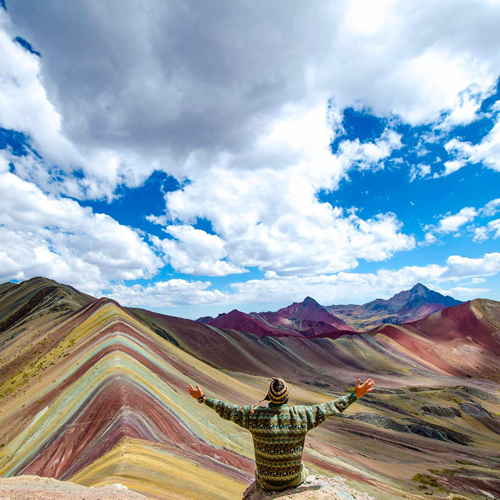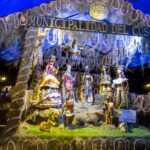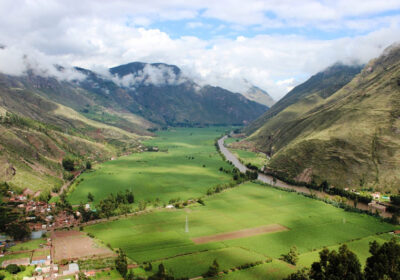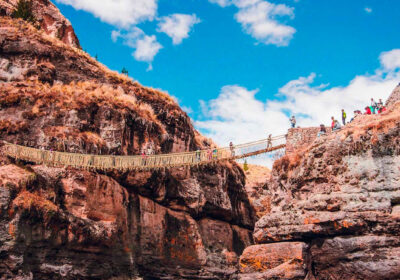
The Lord of Miracles is a spiritual experience. It is also a cultural experience. It is located in the heart of Lima.
Discover the history, traditions, and processions of this October festival, which combines faith, culture, and gastronomy.
Table Of Content
- The History of the Lord of Miracles
- Here’s how to get to the Lord of Miracles procession in Lima
- What to Expect and How to Prepare for the Weather in Lima in October
- The main tourist attractions related to the Lord of Miracles
- 1. Las Nazarenas Shrine and Monastery
- 2. Plaza Mayor in Lima.
- 3. Lima Cathedral.
- 4. Street altars and purple decorations.
- 5. Church and Convent of San Francisco.
- 6. Brotherhood of the Lord of Miracles
- 7. Balconies and colonial houses.
- Here are the details of the Lord of Miracles procession
- First departure: Saturday, October 4, 2025
- Second departure: Saturday, October 18, 2025.
- Third Outing: Sunday, October 19, 2025.
- Fourth Procession: Sunday, October 26, 2025.
- Fifth Outing: Tuesday, October 28, 2025.
- Sixth and final procession: Saturday, November 1, 2025.
- Purple Month Cuisine: Dishes, desserts, and beverages
Devotion to the Lord of Miracles is widespread in Peru and among the most significant in the world. Each October, Lima is adorned in purple to welcome the millions of devotees who accompany the image of the crucified Christ in processions lasting up to twenty hours that wind through the historic streets of the capital. This religious and cultural tradition unites Peruvians from all regions, as well as Peruvian communities abroad.
The History of the Lord of Miracles
The history of the Lord of Miracles originates in the 17th century in Lima, Peru, among African slaves brought by Spanish colonizers. In 1651, an Angolan slave painted an image of a crucified Jesus on a wall in Pachacamilla. Following a devastating earthquake in 1655, this wall remained intact amid widespread destruction, prompting locals to regard it as a miracle and fostering a surge in devotion. Despite efforts by colonial authorities to erase the image, its preservation was seen as divine, enhancing faith in the figure of Christ.
Another earthquake in 1687 also left the image undamaged, leading to the first public procession of a copy of the painting, a tradition that endures today. The Brotherhood of El Señor de los Milagros was founded in 1771 to oversee these processions, establishing distinctive purple robes with white ribbons as symbols of their devotion. Annually in October, the image is carried through downtown Lima, drawing millions and marking one of the largest Catholic processions globally.
The cult of the Lord of Miracles has spread beyond Peru to cities with significant Peruvian communities worldwide, symbolizing faith, hope, unity, and strength for Peruvians, especially during challenging times. Its narrative illustrates religious syncretism and the resilience of Afro-Peruvian heritage, embodying the deep spirituality of Lima’s society for centuries.
Here’s how to get to the Lord of Miracles procession in Lima
The Lord of Miracles procession is held every October in Lima’s historic center. It begins at the Las Nazarenas sanctuary. We recommend using the Metropolitano, a rapid public transportation system, to get there. The Jirón de la Unión and Tacna stations are the closest and are a 5- to 10-minute walk away.
You can also take a taxi or use ride-hailing apps such as Uber or Beat, but keep in mind that there will be heavy traffic and road closures during the procession, which may force you to walk the last part of the way. Another option is to take public buses that run along avenues such as Tacna, Abancay, or Nicolás de Piérola; however, these are not recommended for tourists unfamiliar with public transportation. Arrive at least one hour before the start, especially on October 28, the busiest day. Wear comfortable clothing and footwear, bring water and sunscreen, and keep your belongings safe. In short, the Metropolitano is the most practical and safest option for tourists who want to avoid traffic and congestion.
What to Expect and How to Prepare for the Weather in Lima in October
In October, Lima transitions from the cold, humid winter to the warmer, drier spring. The average temperature ranges from 16°C to 22°C. The weather is mild and pleasant during the day, while mornings and evenings can be cool.
Lima has a dry coastal desert climate, so October is one of the driest months. Humidity is moderate, and cloudy or slightly foggy mornings are common, but heavy rains are rare.
Tourists should bring light clothing for the day and warm clothing for cooler hours, as well as sunscreen. Those attending the Lord of Miracles procession should be prepared to walk outdoors for several hours, so wearing a hat or cap is useful.
In summary, October is an ideal month for enjoying outdoor events and visiting Lima, as it has pleasant weather and little chance of rain.
The main tourist attractions related to the Lord of Miracles
1. Las Nazarenas Shrine and Monastery
Location: Av. Tacna 100, Lima Cercado. Lima Cercado.
Importance: The original image of the Lord of Miracles, painted on an adobe wall in the 17th century by an Angolan slave, is kept here.
What it offers tourists:
You can view the original mural inside the temple.
The temple is also the starting point for the procession on October 18th.
Throughout the month, the faithful come to pray and light candles.
Interesting fact: The temple houses the Monastery of the Discalced Carmelite Nuns of Las Nazarenas, a cloistered community that guards the image.
2. Plaza Mayor in Lima.
Location: Historic Center of Lima.
Importance: A symbolic space in the city where the procession makes an important stop.
What it offers tourists:
Views of historic buildings, such as the Government Palace, Lima Cathedral, and Lima City Hall.
The area is specially decorated with flowers and purple ribbons in October.
It is a popular spot for taking photographs and observing collective devotion.
Historical fact: The Plaza Mayor has been the heart of Lima since its founding in 1535.
3. Lima Cathedral.
Location: Plaza Mayor, opposite the Government Palace.
Importance: it is the main center of Catholic worship in Lima.
What it offers tourists:
– Impressive colonial architecture.
Altarpieces, side chapels, and the tomb of Francisco Pizarro.
Prayer spaces and special masses during the month of October.
Interesting fact: although the image of the Lord of Miracles does not always enter, it usually passes by and is greeted by the archbishopric.
4. Street altars and purple decorations.
Location: Along the procession route, including Tacna Avenue, Huancavelica Street, and Chancay Street.
Importance: They reflect popular devotion and are a living symbol of the “Purple Month.”
What tourists will see:
Decorated scenes with flowers, images, incense, and candles.
The opportunity to take photographs and appreciate local creativity.
Direct contact with the local population and their traditions.
Cultural Curiosity: Many of these altars are organized by families or businesses that have followed this tradition for generations.
5. Church and Convent of San Francisco.
Location: Jr. Lampa, Block 3, Lima.
Importance: A historical monument located very close to the procession route.
What it offers tourists:
– A visit to the famous catacombs.
An ancient library with colonial texts.
Beautiful Baroque architecture, which is typical of Lima.
Interesting fact: During the month of October, the church is decorated with purple details, and special masses are held.
6. Brotherhood of the Lord of Miracles
Location: Mainly active at the Sanctuary of Las Nazarenas and along the procession route.
Importance: This religious group has been responsible for organizing the procession since the 18th century.
What it offers tourists:
– Watch the bearers carry the platform (some with over 20 years of experience).
Observe the songs, prayers, and discipline of the crews.
Learn the meaning of the purple habit and white rope.
Interesting fact: It is one of the largest brotherhoods in the Catholic world.
7. Balconies and colonial houses.
Location: Tacna Avenue, Jirón de la Unión, and Jr. Junín, and the streets of the Historic Center.
Importance: These sites are historical witnesses to the annual procession.
What they offer tourists:
Elevated and privileged views of the procession route.
Special decorations include purple mantles, flowers, and religious posters.
There is an opportunity to take panoramic photos of the crowd and the float.
Cultural fact: Some old houses open their doors so the public can watch the procession from the balconies.
Here are the details of the Lord of Miracles procession
First departure: Saturday, October 4, 2025:
The first procession of the Lord of Miracles will depart on Saturday, October 4, from the Las Nazarenas Shrine on Tacna Avenue in downtown Lima. Scheduled to depart at noon, it marks the official start of the purple month. That day also celebrates the “Levantada Mundial,” during which brotherhoods from Peru and around the world simultaneously raise the platform in a gesture of unity and faith.
The image will travel through downtown streets, including Tacna Avenue, Emancipación Avenue, Chancay Street, and Conde de Superunda Street, before returning to the Las Nazarenas temple. Although it is a short journey, it is very significant, as it represents the reunion of the people of Lima with their Cristo Moreno.
Second departure: Saturday, October 18, 2025.
This procession is one of the most emblematic and well-attended. Starting at 6:00 a.m., the image will leave the Sanctuary of Las Nazarenas and travel along Tacna Avenue toward Jirón Ica, then continue on Jirón de la Unión, and finally enter the Plaza Mayor of Lima.
Important official tributes will be paid in the plaza by the President of the Republic, the Municipality of Lima, and the Archdiocese of Lima. Then, the procession will continue along Jirón Carabaya and Jirón Ucayali to Avenida Abancay, which it will follow until reaching Jirón Junín. There, the Congress of the Republic will offer its traditional tribute. Finally, the image will enter the Church of Carmen, where it will spend the night.
Third Outing: Sunday, October 19, 2025.
Starting at 6:00 a.m., the third procession will take place on Sunday, October 19. This time, the image of the Lord of Miracles will leave the Church of Carmen and visit various healthcare institutions on a journey filled with spirituality and solidarity with the sick.
It will pass by Dos de Mayo and Guillermo Almenara hospitals, stopping to receive tributes from patients and medical staff. Then, it will continue through downtown Lima streets, such as Jirón Huánuco, Jirón Puno, Jirón Antonio Bazo, Jirón Tarata, and Jirón Cangallo. It will return to the Sanctuary of Las Nazarenas at the end of the day.
Fourth Procession: Sunday, October 26, 2025.
One of the major changes this year is that the fourth procession will take place on this date. The Lord of Miracles will travel through the streets of Callao in an extraordinary procession, which has not occurred for over 20 years. Due to the distance and logistical issues, the procession will use the “Nazareno Móvil,” a special vehicle that will carry the image solemnly and safely.
The procession will depart from downtown Lima, travel along Nicolás de Piérola Avenue, and continue along the main roads to the port: Óscar R. Benavides, La Marina, Guardia Chalaca, and Sáenz Peña. This allows the faithful of the port city to venerate the image. It will be a historic and emotional day for Callao’s believers.
Fifth Outing: Tuesday, October 28, 2025.
This procession is the central event of the Lord of Miracles festival. Early in the morning, the image will leave the sanctuary and visit places related to caring for those in greatest need.
Highlights of this procession include the Archbishop Loayza Hospital and the Church of Our Lady of the Forsaken, where special masses and tributes will be held. The route passes through Tacna, Nicolás de Piérola, Alfonso Ugarte, and Venezuela avenues and Cañete, Recuay, Mariano Moreno, and Loreto streets before returning to the temple.
Sixth and final procession: Saturday, November 1, 2025.
On this day, the closing procession will finally take place. Although this last procession is shorter than the previous ones, it is very significant because it marks the official end of the purple month. As is tradition, the image of the Lord of Miracles will travel through some of the streets near the sanctuary once again.
The route includes Tacna Avenue, Callao Street, Chancay Street, and Emancipación Avenue before returning to the Sanctuary of Las Nazarenas. The image will remain there until next year. The day is marked by songs, prayers, and the fervor of the faithful, and is a time for reflection and gratitude for the miracles received.
Purple Month Cuisine: Dishes, desserts, and beverages
Typical Peruvian dishes offer a rich diversity of flavors and traditions. One such dish is carapulcra, a traditional stew made with dried potatoes, pork or chicken, ají panca chili peppers, and various spices. It is especially popular during the Señor de los Milagros festivities. Cau Cau is a tripe stew with potatoes, yellow chili peppers, and aromatic herbs. It is a popular dish in Lima.
Another traditional stew is **seco de res or seco de cabrito**. It consists of meat marinated in chicha de jora, yellow chili peppers, cilantro, and spices. It is commonly served with rice and beans. Pachamanca, on the other hand, is an Andean dish consisting of meat and tubers cooked underground with hot stones. It is more common in the highlands, but some families prepare it in October.
As for desserts, purple mazamorra stands out as an emblematic dish made with purple corn, dried fruits, and spices. It is enjoyed throughout the Month of Purple. Rice pudding, a classic dessert, is made with rice, milk, sugar, and cinnamon. It is usually served cold or warm and is often accompanied by purple mazamorra.
Traditional sweets such as turrones and alfajores are common at celebrations, while mantecadas and bizcochos are sweet breads found in bakeries during the festivities.
In terms of beverages, chicha morada, a refreshing drink made from purple corn and served cold, is especially popular during the Purple Month. Emoliente, a hot drink made with medicinal herbs, barley, and flax, is popular on cool October mornings. Coffee and hot chocolate, on the other hand, are widely consumed in the evening during religious ceremonies and pair well with traditional desserts.










No Comment! Be the first one.